Our very own recipe testers, who know their way around a kitchen, quickly stepped up when we asked for their best tips for baking. We have that ingenious list here, from using parchment paper to handling sticky dough. Get ready to learn a thing or two!

We love baking. And by “we,” we mean those of us on staff, as well as our recipe testers, who make their way through new as well as old cookbooks and recipes as voraciously as we do. As we peruse the most recent recipes that have caught our attention, we love to benefit from their cumulative experience in terms of tricks and techniques we’d not considered. We’re continually impressed and educated by our recipe testers’ knowledge and ingenuity. Here, some tips for better baking.—LC Editors
How to use parchment paper

The tip I learned from recipe testing is the miracle of lining the pan with parchment paper so that you can “lift” your sheet cake or brownies right out in one step.—Lisa B.
Crumple and then smooth out parchment paper before using it to line any baking pan. It’s easier to press it into the corners and you’re not fighting it to stay put and keep it from curling up.—Olivia B.
When baking a loaf cake, after lining the pan with parchment, I fold the excess paper outward and secure it with metal binder clips to the rim of the loaf pan. This prevents the parchment from flopping inward while I fill the pan and during baking. (Yes, all-metal binder clips are oven safe!)—Chiyo U.
I use a parchment sling for square and rectangular cakes but I buy pre-cut rounds for 6-, 8-, and 9-inch pans. Makes throwing together a cake a snap.—Terry L.
How to impart even more citrus flavor into baked goods

When making any sort of baked good that calls for citrus zest, use your fingers to rub the zest into the sugar to release the oils and intensify the citrus flavor.—Olivia B.
How to turn cold butter to room temp instantly

I’d say my favorite kitchen hack is to soften butter by grating it on a box grater. Butter straight from the fridge goes from hard to room temperature in a matter of seconds!—Callie M.
I keep grated butter in resealable bags in the freezer. The butter is great when you want to make scones, pastry, or really any type of baking for which you need to cut butter into small bits. It also thaws very quickly if you need it at room temperature.—Daniela T.
When I bake and I need room-temperature butter, I use the wrapper from the butter to grease the pan after I’ve removed the butter. There’s usually just the right amount for that purpose.—Marcia L.
How to minimize mess when kneading bread
When I have a light kneading job to do, I often do so in a sheet pan. If you put a silicone mat underneath it won’t slide on the counter. This contains the floury mess and eliminates the thorough countertop cleaning you need to do before turning out your dough.—Pat Scalione
How to roll out pastry or cookie dough

When making pie dough or cookie dough that needs to be refrigerated then rolled, I roll it first between two pieces of plastic wrap, then put it in the refrigerator. It makes it so much easier.—Nadine B. [Editor’s Note: This method was recommended by several of our testers, with the only variation being using parchment instead of plastic wrap.]
Roll all-butter pie crust between two sheets of parchment—you don’t have to cover it in as much flour, it doesn’t stick to the counter/your rolling pin and it’s easy to move it to the fridge if it starts to get warm—a Silpat under the parchment will keep it from moving on you!—Oliva B.
I keep a little shaker jar with flour. It’s great for dusting the counter when making bread or pastry, pans for cakes, or even meats when you need to lightly coat it in flour before browning.—Daniela T.
How to handle sticky dough
Dampen a silicone spatula when working with a sticky dough/batter that you want to spread evenly. It will spread smoothly! You can also pat muffin batter down with dampened fingers if it’s rough and you want a perfectly smooth bake on top.—Lelan D.
If you’re rolling energy balls or cookie dough, dampen your fingers and hands before rolling them into a uniform ball. Your hands will stay clean and the dough balls will be perfectly smooth. The same trick works if you’re using an ice cream scoop to scoop cookie dough—dampen it before scooping, and they’ll slide right out!—Lelan D
This hack has been around for years, but I always cut my cinnamon rolls with unflavored dental floss. It makes a clean cut and doesn’t squish the dough down.—Marcia L.
Originally published December 5, 2021
